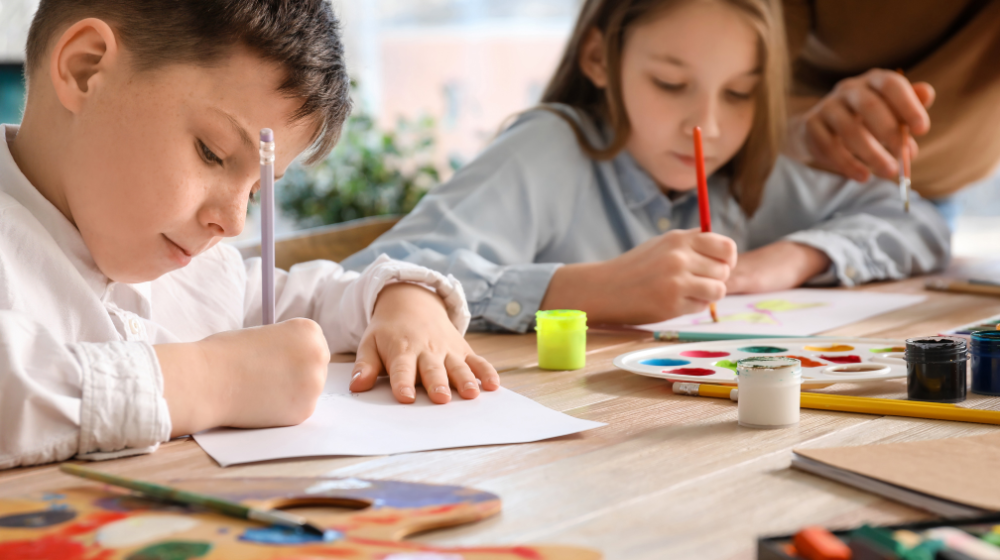Children and young people may struggle to express their emotions verbally, but creative activities can be a therapeutic way for them to understand and cope with their grief.
At The Laura Centre, we recognise the importance of providing holistic bereavement support, not only through traditional counselling but also through creative outlets. Below, we’ve shared various creative activities for bereaved children and young people to complete at home. These activities can encourage your child to open up about their feelings, and navigate the complexities of their emotions.
How Can Creativity Help Bereavement?
Engaging in creative activities offers bereaved children and young people a non-verbal means of expressing complex emotions. Creative outlets provide a safe space for self-expression, allowing children to navigate their grief at their own pace. These activities also promote a sense of agency, empowering children to actively participate in their healing journey.
Creativity has the power to unlock emotions and thoughts that may be difficult to articulate verbally. Through art, writing and other expressive activities, children can externalise their grief, making it more tangible and manageable. This process aids in building resilience and coping skills, crucial elements in navigating the challenging terrain of loss.
From memory jars to thankful trees, here are some bereavement activities for children and young people.

Memory Jars
Memory jars are a beautiful and tangible way for children to honour the memories of their lost loved ones. Gather an assortment of jars, and encourage your child to fill them with small objects that represent special memories. These could be photographs, notes or even small trinkets.
The act of selecting and placing items in the jar helps children reflect on positive memories, fostering a sense of connection and healing. They can also turn to their memory jar when they are feeling particularly low, to reconnect with their lost loved one.
Writing An Unsent Letter
Writing can serve as a powerful tool for processing grief and releasing emotion. Encourage your child to write unsent letters to their loved ones, sharing thoughts and feelings they may find challenging to express verbally. This exercise provides a safe space for children to communicate with the deceased, expressing love, regrets and any unfinished conversations.
Your child may choose to keep the letter, store it in a safe place or dispose of it. This is entirely their choice.
Memory Boxes
Creating memory boxes is a tangible and personal way for children to collect and preserve items that hold sentimental value. Provide a special box and guide the child in selecting items that remind them of their loved one. These could include photos, letters, or even small personal belongings. Having a designated space for cherished memories allows children to revisit them whenever they feel the need, fostering a sense of connection and comfort.
Thankful Tree
Creating a thankful tree is one of the most popular activities for bereaved children. This helps us acknowledge gratitude, by reflecting on the positive memories shared with the bereaved. To get started, provide paper cutouts of leaves, and encourage your child to write down things they are thankful for. As the tree grows, it becomes a visual representation of positivity, providing a counterbalance to the heaviness of grief.

Memory Calendar
Creating a memory calendar is an ongoing project that will help you mark special dates and anniversaries related to the loved one that has died. Provide a calendar, and encourage your child to decorate it with memories and significant dates. This visual representation helps children anticipate difficult days and plan activities to honour this person. It can turn what might be painful reminders into opportunities for remembrance and celebration.
Grief Journal
A final bereavement activity for children and young people is journaling. Journaling is a therapeutic activity that provides an outlet for expressing thoughts and emotions. It’s easy to start too; just provide a journal, and encourage your child to write or draw about their feelings and experiences.
Journaling allows for self-reflection and can serve as a private space for children to process their grief at their own pace. It also provides a record of their journey, highlighting progress and resilience over time.
Bereavement Support In Leicester & Beyond
At The Laura Centre, we recognise the unique needs of bereaved children and young people. Our bereavement counselling services are tailored to meet every person as an individual, respecting the uniqueness of loss.
Grief is a personal journey, and there is no one-size-fits-all approach. If you’re seeking bereavement support in Leicester, contact our team of counsellors today.


